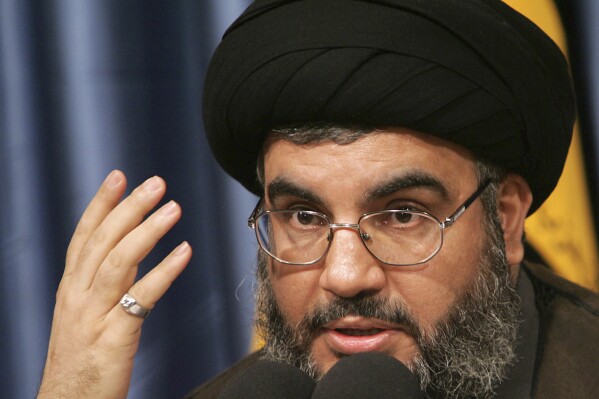The Hezbollah Secretary-General had a concept: He thought he could predict every move by Israel and escape elimination. But the army developed a sophisticated maneuver that only increased his arrogance, until he made a fatal mistake: “He slept on his nose.” Now it is permissible to tell how it worked – and to reveal the secret role that Nasrallah had in the axis of evil.
An in-depth reportage adapted from Walla an Israel communications company provides an insider understanding of the assassination of Hezbollah Chief Hassan Nasrallah.
Major G., a 29-year-old bachelor from Tel Aviv, was apparently one of Hezbollah Secretary-General Hassan Nasrallah ‘s closest acquaintances . Only Nasrallah himself didn’t know it.
He had no idea how many eyes in Israel were following him on the matter, and how the security establishment was closing in on him – until the fatal blow that ended his life last September , and created, as the IDF operation to eliminate him was called, a new order in the entire region.
G. began his service in the Egoz unit, was wounded, and then moved to serve in the Intelligence Branch. He was later appointed intelligence officer of the Northern Brigade in the Gaza Division.
He must have allowed himself to smile with satisfaction over one such “X”: the choke ring he helped Tightening the noose around Nasrallah’s neck worked well – and the most senior terrorist in the Middle East gained intimate familiarity with the Air Force’s bombs .
The turning point with the Hezbollah Secretary General, the army says, came after the explosion of pagers and radios throughout Lebanon – which killed 46 Hezbollah operatives , wounded hundreds, blinded dozens, and shocked and frightened an organization that had previously felt impenetrable.
After the operation, senior officials in the Operations Division of the General Staff made it clear to senior military intelligence and air force officials that conditions had been created that made it possible to attack the wounded snake – and this time to aim for the head.
“It’s quite natural, because when you see all the dots connecting, you understand that we are wisely taking away layer after layer, which were built over 20 years,” explained a senior IDF officer, adding: “Nasrallah did not understand that he was in a war from which he was trying to escape. He went to the brink. How did the Chief of Staff describe it? The IDF put stone after stone in his bag, and he ignored the weight on his back.”
There were quite a few attempts to eliminate Nasrallah, but the system was not mature enough for that. Hezbollah still had its capabilities; if it had used them, enormous damage would have been caused to the Israeli rear. Major G’s role was to point out the moments when opportunities arose to harm Nasrallah; moments that at a certain point became more frequent.
It happened on Friday, September 27. Shortly after 6:00 PM, the time for the “Salat al-Maghrib” prayer arrived, after sunset. The ground crews of Squadron 69 at Hatzerim Base finished arming the Thunder planes.
But to understand the whole story and the full picture, one must go back in time. On October 7, 2011, Nasrallah was surprised by the timing that Hamas leader Yahya Sinwar chose to launch an attack on Israel.
Fuad Hussein’s departure effectively blinded Nasrallah. According to intelligence sources, when Hezbollah’s Secretary General wanted to make decisions and impose them on field commanders, he would immediately summon the organization’s Chief of Staff; Shukar was the only person who managed to connect the terrorists with Hezbollah’s senior command, build a picture of the situation, and determine what Israel had attacked in the past 24 hours and what had not. After Shukar, most of Hezbollah’s division and brigade commanders were assassinated, and the organization’s plight became many times more acute.
The Chief of Staff continued to press the gas pedal even after the assassination that stunned Hezbollah. Nasrallah, according to the research division in the Intelligence Directorate, assessed that Israel did not want an all-out war.
This, despite operations such as “This is the Moment,” which were promoted by the Operations Directorate in the General Staff in cooperation with the Air Force and the Intelligence Directorate, with the aim of damaging the organization’s sensitive structures.
After two weeks of coordination between the Military Intelligence and the Mossad, on September 17-18, the prime minister decided, despite objections from the security establishment, to launch a pager attack in Lebanon.
On September 20, Sergeant Major G. received sensitive information about the whereabouts of Ibrahim Akil , head of Hezbollah’s operations department and de facto commander of the Radwan Force, who had “risen in rank” after a series of assassinations at the top of the organization.
Intelligence indicated that he had convened a large meeting with senior field commanders of the Radwan Force in a suburb of Beirut, including Ahmed Mahmoud Wahbi, head of the Radwan Force’s training department and the force’s former operations commander, in preparation for a ground raid on Israel.
With his elimination, the Hezbollah Secretary-General’s circle of advisors shrank. “Nasrallah received gradual anesthetic injections after the rocket hit Majdal Shams,” says a senior IDF official.
“He didn’t understand that Israel had long since broken the equation and was going after him. Until the last second, he conducted himself, as if it were business as usual” – a complacency that is reminiscent of the way Israel itself was “put to sleep” by Sinwar before October 7.
Three days later, on September 23, the Chief of Staff approved Operation Northern Arrows , in which the IDF destroyed Hezbollah’s strategic capabilities and in effect deprived it of a cumulative 80% of its firepower and its remaining command and control capabilities – or as they say in the Air Force, “the ability to retaliate with large volleys.”
“His strength became his weakness”
An officer in the Operations Branch jokingly said that every time they called Major G to inquire about certain senior Hezbollah figures, his list of surveillance targets got shorter and shorter; they were simply eliminated one by one.
“There was a point where it wasn’t necessary to explain to the people at headquarters that they were going after Nasrallah,” says the officer. “It went there quite naturally. Especially when he refused to understand the strong hints to stop the equation of connection to the Gaza Strip, and to stop the launches and attacks on Israel.”
Long days of discussions and consideration of alternatives slowly led to the decision to assassinate him. “It was clear to everyone that if such an operation failed, Nasrallah would emerge from it in the status of a god,” said a source involved in the decision-making leading up to the assassination of the Hezbollah Secretary-General.
But where was Nasrallah when the decision was made? The intelligence received indicated that he had arrived at one of the organization’s underground headquarters in Dahiyya.
The headquarters was in a seemingly peaceful neighborhood, which is hard to imagine that such an elaborate evil mechanism was hidden beneath it: about 20 buildings, close together, with a dense grove of trees on their western side.
The intelligence branch and the Air Force knew that if the operation was not planned down to the last detail, Nasrallah might realize that he was a target for assassination – and it is difficult to know when, if ever, another opportunity to harm him would arise.
“The understanding began in Israel that something was happening underground,” explains a source familiar with the details, adding that in recent years, contrary to popular opinion in Israel, he had not always been in bunkers and had also been walking around above ground quite a bit . “It was clear that there was a window of time, and that it was getting shorter,” says the same source.
Intelligence veterans who were in the “pit” at the time testified that they suddenly understood how 18 years of collection and research work, since the Second Lebanon War , during which there was no information about where Nasrallah was hiding, was being drained into a single moment of targeted thwarting.
This happened thanks to intelligence from all the organizations, and not least thanks to the previous head of the operations brigade, Brigadier General G., who was responsible for integration between the bodies, and thanks to Major G. and the soldiers around him.
The Air Force held a special discussion, headed by the head of the Air Operations Division, Brigadier General Gilad Keinan, who, along with the heads of the departments under him, tried to figure out how to attack targets in crowded areas without killing a large number of uninvolved people. They came up with the idea of calling on civilians in whose areas Hezbollah had missiles to evacuate their homes.
The idea was conveyed to the IDF spokesman, and was successfully implemented: the Lebanese public internalized the messages. “It worked. “Nasrallah didn’t think that in this war the IDF would control the decision where its citizens would go,” said an air force officer, “but at the same time, we feared that he would turn Lebanon into a main arena against us, while we were fighting with full force in the Gaza Strip. We were prepared for surprises.”




















